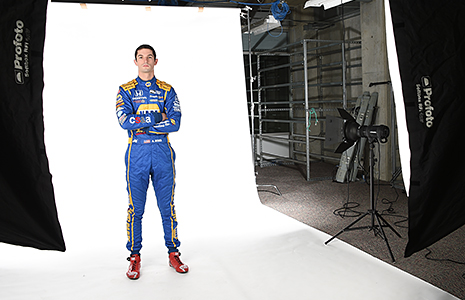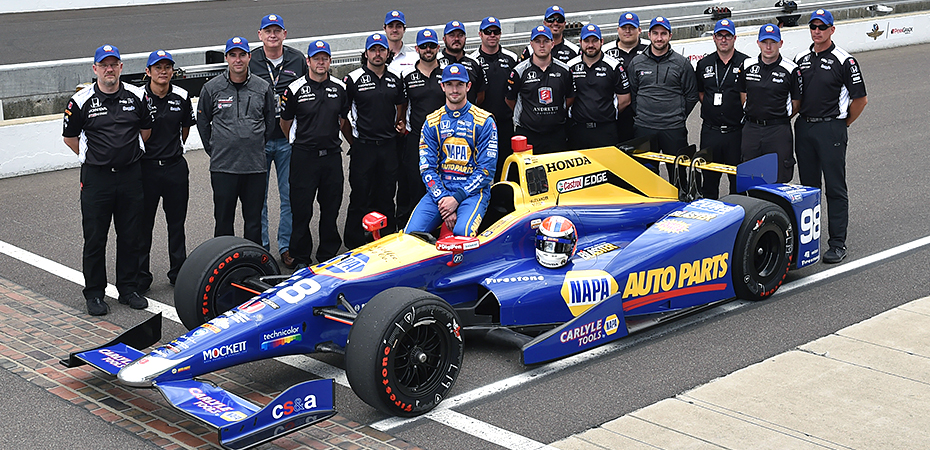(This is the second of a four-part series by noted motorsports reporter Will Buxton chronicling the incredible 2016 journey of Alexander Rossi, from little-known Verizon IndyCar Series rookie to champion of the historic 100th Running of the Indianapolis 500 presented by PennGrade Motor Oil. Stay tuned throughout the week for the final installments. Read Part 1 here.)
Little more than two months removed from making the leap to Verizon IndyCar Series racing, Alexander Rossi was staring at the prospect of taking on the most fickle of racetracks, the hallowed Indianapolis Motor Speedway.
True, he’d survived his first oval a month earlier, finishing 14th at Phoenix Raceway even though he tapped the wall late in the race to bring out the last caution flag. But the mile track at Phoenix is nothing like the cavernous 2.5-mile Indy oval, with its daunting squared turns.
 As with all Indianapolis 500 first-timers, Rossi had to go through rookie orientation to pass the requisite speed challenges and be permitted to race in the 100th Indianapolis 500 presented by PennGrade Motor Oil. Rossi had never experienced a sensation like it.
As with all Indianapolis 500 first-timers, Rossi had to go through rookie orientation to pass the requisite speed challenges and be permitted to race in the 100th Indianapolis 500 presented by PennGrade Motor Oil. Rossi had never experienced a sensation like it.
“When you get to the speedway, you take away all that downforce and all of a sudden you feel like you’re on a 650-horsepower skateboard where one gust of wind will push the car halfway across the track,” Rossi said. “The margin for error is so small. If you have understeer, you’re heading into the wall at 220 mph. If you have oversteer, you’re spinning and it’s over. There’s the thinnest line that you’re trying to balance on, all the while driving absolutely on the limit.
“I didn’t find that groove immediately,” he admitted. “I went out and the first speed you have to do is 185, which was super easy. Then it was 200, which was pretty easy. The next target was 215-plus for the final stage to get your qualification, and it was diabolical.
“And so I came in (to the pits) and I hadn’t graduated yet because I hadn’t done 15 laps over 215, and I was like, ‘I’m either not capable of doing this or there is something wrong.’”
A quick trip to the garage and the No. 98 Andretti Herta Autosport with Curb-Agajanian Honda was put on the setup pad. A quick change to reduce the amount of rear toe and the rookie was sent back out. Fifteen laps at 228 mph. Orientation complete.
“For sure that gave me confidence,” Rossi said.
But speed is only part of the puzzle at Indianapolis. The art of pack racing was new to Rossi as well.
“Andretti makes a point each day of practicing group running, at least a whole hour a day just running in traffic. By the third day, I still couldn’t pass people. My car was going to hell. So I asked Townsend Bell (who was driving a fifth Andretti Autosport entry in the 2016 race) for some advice. He looked at me and he just said, ‘It’s not supposed to feel right, it’s supposed to be primal. None of us are comfortable, you just have to accept it and deal with it.’
“Once I had the information that everyone else was struggling, I was fine with it and figured out how to start passing.”
With his pace and pack mentality honed, he had to qualify for the race. Fastest in practice the morning of first-day qualifying, Rossi put a marker down with his first qualifying run and sat, happily, on his time. Remaining in the top three positions for most of the day, as the sun started to set and the track started to cool, the lap times started to drop. Rossi, who felt he could have been second or third on the day, was out of the fast nine who advanced to the pole shootout the following day. He was P11.
“Missing out on the fast nine actually worked out OK,” he concedes. “We were suffering with an engine which was dying a bit of a death. So even if we’d got through, we’d have been ninth at best. It almost worked out better that I was 11th.”
And so to race day, one of the most fevered and expectant days in all of motor racing. The pomp and ceremony around the Indianapolis 500 makes it so emotional as to be an almost spiritual event. Yet Rossi remained calm.
“A lot of my lead-up to that Sunday at noon was framed by naivete because I didn’t know what it was about and what 350,000 people (in the stands) and that grid was going to be like. Because of that, it was very much just another race for me. We were four races into the season and I was hungry for a result.”
When it comes down to it, Rossi is a racer. And after the many weeks of build-up, deep down he simply wanted to feel the close comfort of his race helmet, the belts pulled tight against his chest and his foot resting on the gas.
“Honestly, I was just looking forward to getting into the race car so much. You talk all the time about the 500 and what it’s going to be like and all these media events and blah-blah-blah, and when you finally get into the car to race you’re like, ‘Thank God! We finally get to do this!’”
Next in Part 3: Pit stop disaster leads to the ultimate gamble
